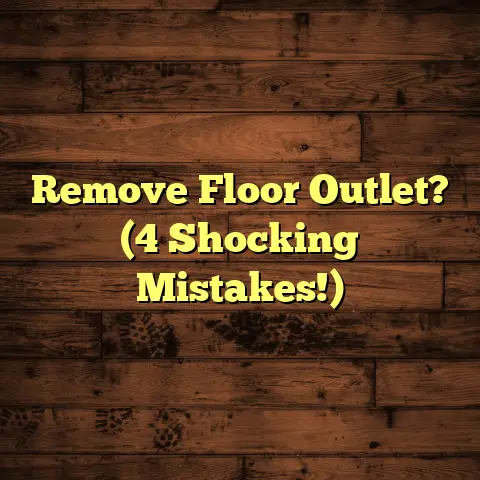Slippery Wood Floors: Why? (2 Fall Risks Hidden!)
Wood flooring is a timeless choice, right? It adds warmth, elegance, and value to any space. I’ve installed miles of it over my career.
But let’s be honest, sometimes that beautiful sheen can be a little too slick. Have you ever felt like you’re ice-skating across your living room?
The increasing popularity of wood flooring in homes and commercial spaces has been remarkable. We’re seeing a surge in home renovation projects that prioritize hardwood floors, and that’s fantastic!
But with this trend, it’s crucial to understand potential flooring-related safety issues.
Why are wood floors slippery? And what hidden dangers are lurking beneath that glossy surface? Let’s dive in and uncover the truth.
Section 1: Understanding
Slippery Wood Floors
Defining Slipperiness in
Wood Flooring
What exactly do I mean by “slippery?” Well, it’s when your foot doesn’t get enough grip on the floor, causing you to slide or lose balance.
This isn’t just about how shiny the floor is. The surface finish and texture play a huge role. A super smooth, high-gloss finish will naturally be more slippery than a textured, matte one.
Think about it: a bowling alley floor is intentionally slippery, while a basketball court is designed for maximum traction. The finish makes all the difference!
Factors Contributing to Slipperiness
So, what makes a wood floor slippery in the first place? Several factors can contribute, and it’s essential to understand them to address the problem.
Humidity and Moisture Levels
Wood is a natural material, and it’s very sensitive to changes in humidity. When the air is humid, wood absorbs moisture and expands.
Conversely, in dry conditions, it loses moisture and shrinks. This expansion and contraction can affect the floor’s surface, making it more prone to slipperiness.
I’ve seen floors become noticeably slicker during the humid summer months. The extra moisture creates a thin film on the surface, reducing friction.
Type of Finish Used
The type of finish you choose for your wood floor significantly impacts its traction. There are two main types: oil-based and water-based finishes.
-
Oil-based finishes tend to create a harder, more durable surface, but they can also be more slippery. They often have a higher gloss level, which contributes to the slickness.
-
Water-based finishes, on the other hand, generally provide better traction. They tend to have a slightly softer feel and are available in matte or satin options, which reduce slipperiness.
I always advise my clients to consider the finish carefully, especially if they have young children or elderly family members.
Wear and Tear
Over time, even the best wood floors will show signs of wear and tear. Scratches, scuffs, and worn-down areas can affect the surface and lead to slipperiness.
Think about it: a brand-new floor has a consistent texture and finish. But as it gets used, high-traffic areas can become smoother and more polished, reducing friction.
I’ve seen floors where the finish has completely worn away in certain spots, making them incredibly slippery. Regular maintenance and refinishing can help prevent this.
Cleaning Products
Believe it or not, the cleaning products you use can also contribute to slippery floors. Some cleaners leave behind a residue that creates a slick surface.
Avoid using products that contain oils, waxes, or polishes, as these can build up over time and make the floor more slippery.
I always recommend using a pH-neutral cleaner specifically designed for wood floors. And remember, less is more! Don’t over-saturate the floor when cleaning, as excess moisture can also cause problems.
Section 2: The Hidden Risks of
Slippery Wood Floors
Okay, so we know what makes wood floors slippery. But what are the actual risks? Let’s explore two hidden dangers that you might not have considered.
Fall Risk #1: Environmental Hazards
One of the biggest culprits when it comes to slippery floors is environmental factors. Things like water, snow, and ice can easily be tracked indoors, creating hazardous conditions.
Think about it: on a rainy day, you’re likely to bring in moisture on your shoes. This water can quickly turn a perfectly safe wood floor into an ice rink.
Snow and ice are even worse. They melt slowly, creating puddles that can be incredibly slippery. According to the CDC, falls are a leading cause of injury and death in the United States. CDC Fall Statistics
Seasonal influences also play a role. Wet or humid weather can increase the moisture content of your floors, making them more slippery.
I always advise my clients to invest in good quality doormats to trap dirt and moisture before they reach the wood floors. And encourage everyone to remove their shoes when they come inside.
Fall Risk #2: Lifestyle and
Behavioral Factors
Our daily activities and lifestyle choices can also contribute to fall risks on wood floors. Things like footwear, furniture arrangement, and mobility issues can all play a role.
-
Footwear: Walking around in socks or slippers on a wood floor can be a recipe for disaster. These types of footwear often have very little traction, making it easy to slip and fall.
I always recommend wearing shoes with rubber soles or non-slip socks when walking on wood floors.
-
Furniture and Décor: The arrangement of furniture and décor can also create obstacles that lead to falls. Cluttered hallways, loose rugs, and poorly placed furniture can all increase the risk of tripping.
I suggest keeping walkways clear and securing rugs with non-slip pads.
-
Age and Mobility: Age and mobility issues can significantly exacerbate the risks associated with slippery wood floors. Older adults are more likely to experience balance problems and muscle weakness, making them more susceptible to falls.
According to the National Council on Aging, falls are the leading cause of injury and death from injury among older Americans. NCOA Fall Prevention Facts
I always recommend that older adults and those with mobility issues use assistive devices like canes or walkers when walking on wood floors. Grab bars in bathrooms and handrails on stairs can also help prevent falls.
Section 3: Statistical Insights
and Case Studies
Let’s take a look at some real-world data to understand the impact of slip and fall accidents on wood floors.
-
National Statistics: According to the National Safety Council, falls are a leading cause of unintentional injuries and deaths in the United States. While not all falls occur on wood floors, a significant percentage do.
-
Demographic Data: Older adults are disproportionately affected by falls. The CDC reports that one in four older adults falls each year, and falls are the leading cause of injury and death from injury among this age group.
Here’s a table showing the rates of fall injuries among older adults (65+) per 100,000 population:
| Year | Fall Injury Rate |
|---|---|
| 2010 | 2,080 |
| 2015 | 2,450 |
| 2020 | 2,700 |
(Source: CDC National Center for Health Statistics)
-
Case Studies: I’ve personally seen the devastating consequences of slip and fall accidents on wood floors. I remember one client, an elderly woman, who slipped on her newly polished wood floor and broke her hip. She required surgery and months of rehabilitation, and her quality of life was significantly impacted.
Another client, a young child, slipped on a wet wood floor and suffered a concussion. These incidents highlight the importance of taking precautions to prevent slip and fall accidents on wood floors.
Section 4: The Science Behind
Wood Flooring and Traction
Let’s get a little technical and explore the science behind wood flooring and traction. Understanding the physics of slipperiness can help us find effective solutions.
The Physics of Slipperiness
Friction is the force that opposes motion between two surfaces in contact. The amount of friction depends on the materials involved and the force pressing them together.
A slippery surface has low friction, meaning it’s easy for objects to slide across it. A rough surface has high friction, making it harder to slide.
The coefficient of friction is a measure of how much friction exists between two surfaces. A higher coefficient of friction indicates a less slippery surface.
Different types of wood and finishes have different coefficients of friction. For example, a smooth, high-gloss finish will have a lower coefficient of friction than a textured, matte finish.
Texture and grain patterns also influence traction. A wood floor with a pronounced grain pattern will generally provide better grip than a floor with a smooth, uniform surface.
Innovations in Wood Flooring
Technology
Fortunately, manufacturers are constantly developing new technologies to reduce slipperiness in wood flooring.
-
New Finishes: Some manufacturers are creating finishes with added texture or grip-enhancing additives. These finishes provide better traction without compromising the aesthetic appeal of the wood.
-
Anti-Slip Materials: Some flooring products incorporate anti-slip materials like rubber or cork into the surface. These materials provide excellent traction, even when wet.
-
Textured Surfaces: Some manufacturers are creating wood floors with textured surfaces that provide better grip. These surfaces can be achieved through various techniques, such as wire-brushing or hand-scraping.
I’m excited to see these innovations continue to improve the safety of wood flooring.
Section 5: Conclusion
We’ve covered a lot of ground in this article. We’ve explored the reasons behind slippery wood floors and the hidden fall risks they pose.
It’s essential to understand that slippery wood floors are not just an inconvenience. They can be a serious safety hazard, especially for vulnerable populations like the elderly and young children.
By taking steps to reduce slipperiness, such as using appropriate cleaning products, maintaining the finish, and addressing environmental hazards, we can create safer homes and workplaces.
Increased awareness and education are crucial. We need to educate homeowners, landlords, and building managers about the risks associated with slippery wood floors and the steps they can take to prevent falls.
I believe that future innovations in wood flooring will prioritize safety without compromising aesthetics. We can look forward to new finishes, materials, and technologies that provide excellent traction while still maintaining the beauty and elegance of wood.
Thanks for reading! I hope this article has been helpful and informative. Stay safe out there!





